
Rutidosis leptorrhynchoides, commonly known as button wrinklewort, is a flowering plant in the family Asteraceae. It is an upright, tufted, perennial herb with bright green leaves and yellow button-shaped flowers.

Olearia axillaris, commonly known as coastal daisy-bush, coast daisy-bush or coastal daisybush is a species of flowering plant in the family Asteraceae and is endemic to coastal areas of Australia. It is an erect, bushy shrub with densely cottony-hairy branchlets, aromatic, linear to narrowly elliptic or narrowly lance-shaped to egg-shaped leaves with the narrower end towards the base and small white and yellow, daisy-like inflorescences.

Goodenia macmillanii, commonly known as pinnate goodenia, is a species of flowering plant in the family Goodeniaceae and is endemic to Victoria, Australia. It is an erect, short-lived perennial shrub with lyrate or lobed leaves, egg-shaped to elliptic in outline with toothed edges, and leafy racemes of bluish-purple flowers.

Goodenia stobbsiana is a species of flowering plant in the family Goodeniaceae and is endemic to the north-west of Western Australia. It is a sticky, much-branched, perennial subshrub with egg-shaped to lance-shaped leaves with the narrower end towards the base and thyrses of blue flowers.

Cassinia subtropica, commonly known as bushy rosemary, is a species of flowering plant in the family Asteraceae and is endemic to north-eastern Australia. It is shrub with woolly-hairy stems, lance-shaped to egg-shaped leaves and panicles of flower heads.

Brachyscome graminea, commonly known as grass daisy, is a perennial herb in the family Asteraceae and is endemic to Australia. It has mostly mauve-pink or purple daisy-like flowers and a yellow centre.
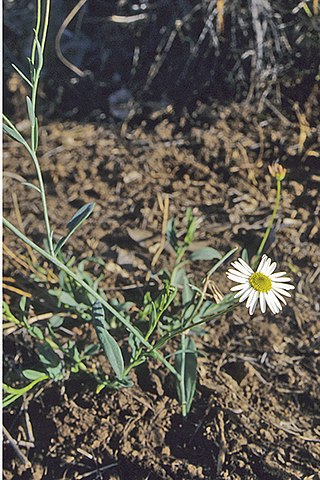
Brachyscome basaltica, commonly known as swamp daisy, is a perennial herb in the family Asteraceae and is endemic to Australia. It has mostly white daisy-like flowers and a yellow centre.
Goodenia corynocarpa is a species of flowering plant in the family Goodeniaceae and endemic to near-coastal areas in the west of Western Australia. It is a herb with linear to elliptic leaves at the base of the plant, and racemes of yellow flowers.

Goodenia eatoniana is a species of flowering plant in the family Goodeniaceae and is endemic to the extreme south-west of Western Australia. It is a perennial herb with lance-shaped leaves at the base of the plant, egg-shaped stem leaves, and racemes of blue flowers.

Goodenia heterochila, commonly known as serrated goodenia, is a species of flowering plant in the family Goodeniaceae and is endemic to arid areas of Australia. It is an erect or ascending perennial herb with lance-shaped to egg-shaped stem leaves with the narrow end towards the base, and racemes of yellow flowers with a brownish centre.

Goodenia heteromera, commonly known as spreading goodenia or fan flower, is a species of flowering plant in the family Goodeniaceae and is endemic to south-eastern Australia. It is a perennial or annual, stolon-forming herb with lance-shaped to egg-shaped leaves with the narrow end towards the base, and racemes of yellow flowers with brownish markings.

Goodenia hirsuta is a species of flowering plant in the family Goodeniaceae and is endemic to northern Australia. It is a hairy, prostrate to low-lying perennial herb with narrow egg-shaped leaves at the base of the plant, racemes of hairy yellow flowers and oval to elliptic fruit.

Goodenia microptera is a species of flowering plant in the family Goodeniaceae and is endemic to the Pilbara region of Western Australia. It is an erect to ascending, sprawling herb with narrow oblong to lance-shaped leaves sometimes with teeth on the edges, and racemes of yellow flowers with a brownish centre.
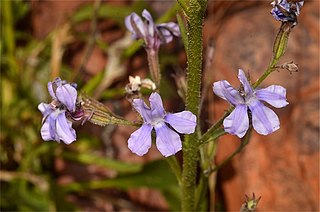
Goodenia ramelii is a species of flowering plant in the family Goodeniaceae and is endemic to central Australia. It is a perennial herb with toothed, elliptic leaves in a rosette at the base of the plant, and racemes of blue flowers.

Goodenia scaevolina is a species of flowering plant in the family Goodeniaceae and is endemic to the north-west of Australia. It a perennial subshrub with egg-shaped to lance-shaped leaves, the narrower end towards the base, and thyrses of blue flowers.
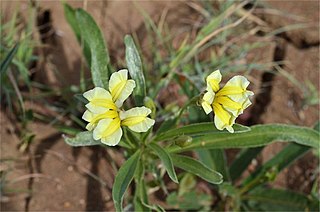
Goodenia strangfordii, commonly known as wide-leaved goodenia in the Northern Territory, is a species of flowering plant in the family Goodeniaceae and is endemic to northern Australia. It is an erect herb with narrow elliptic to lance-shaped stem leaves with the narrower end towards the base, and racemes of yellow flowers.
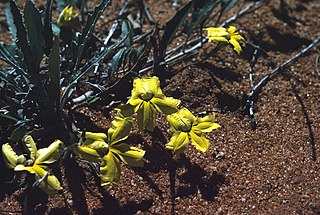
Goodenia xanthosperma, commonly known as yellow-seeded goodenia, is a species of flowering plant in the family Goodeniaceae and is endemic to southern inland Western Australia. It is a prostrate herb with elliptic to egg-shaped leaves at the base of the plant and racemes of yellow flowers with purplish markings.
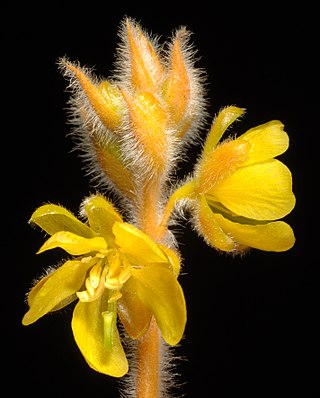
Senna notabilis, commonly known as cockroach bush, is a species of flowering plant in the legume family Fabaceae, and is endemic to northern Australia. It is an erect, softly-hairy, annual or perennial shrub with pinnate leaves with six to twelve pairs of lance-shaped leaflets, and yellow flowers arranged in groups of twenty to thirty, with seven fertile stamens in each flower.
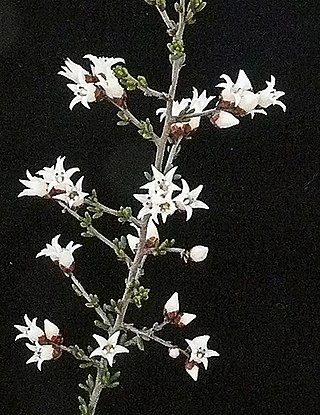
Cryptandra magniflora is a species of flowering plant in the family Rhamnaceae and is endemic to Victoria (Australia). It is a shrub with cylindrical leaves, and clusters of white, tube-shaped flowers.
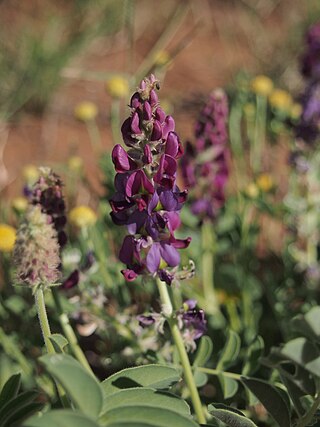
Swainsona canescens, commonly known as grey swainsona, is a flowering plant in the family Fabaceae. It is a small perennial herb with pink-purple or purple, yellow and green flowers and grows in Queensland, Western Australia and South Australia.




















